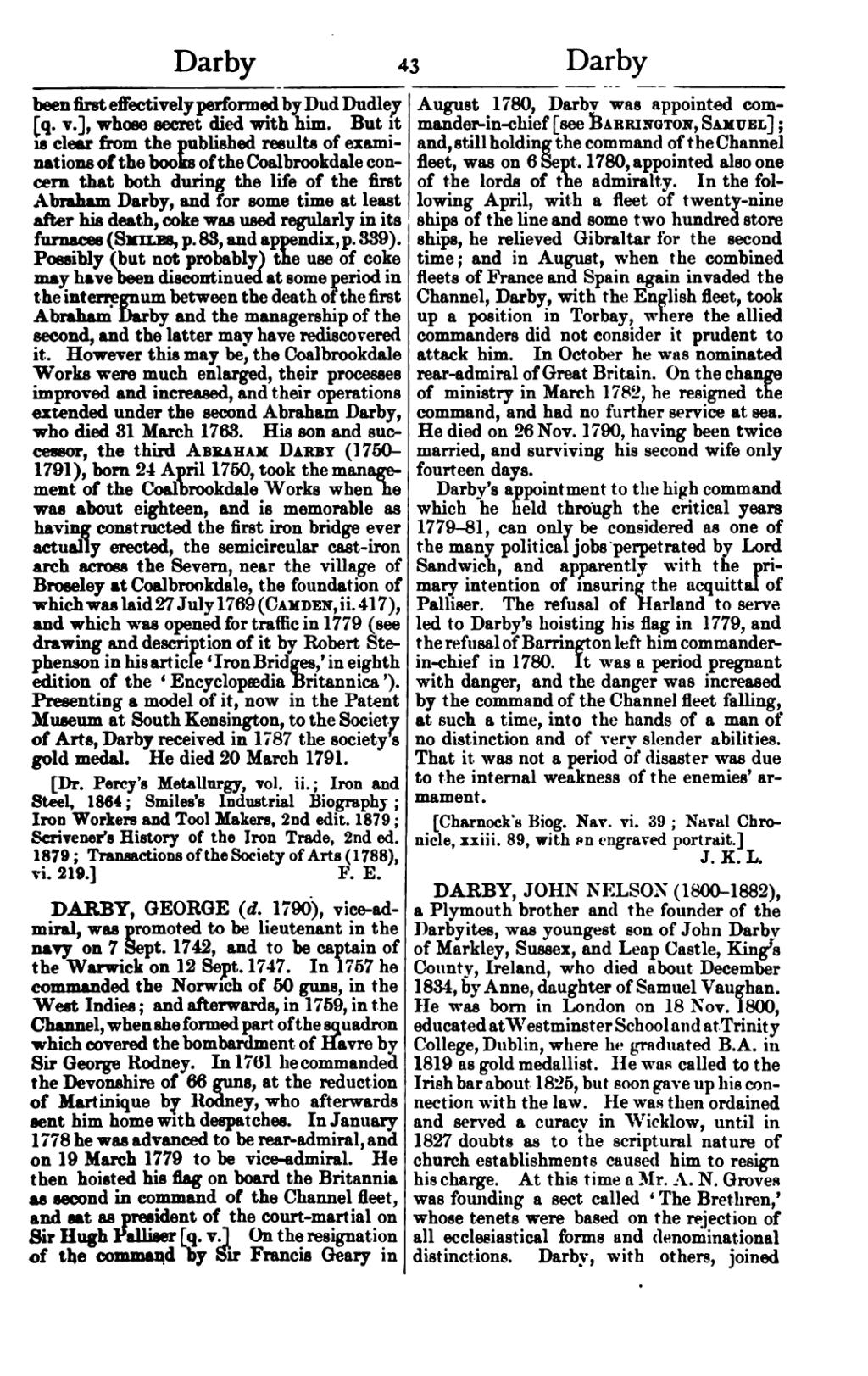been first effectively performed by Dud Dudley [q. v.], whose secret died with him. But it is clear from the published results of examinations of the books of the Coalbrookdale concern that both during the life of the first Abraham Darby, and for some time at least after his death, coke was used regularly in its furnaces (Smiles, p. 83, and appendix, p. 339). Possibly (but not probably) the use of coke may have been discontinued at some period in the interregnum between the death of the first Abraham Darby and the managership of the second, and the latter may have rediscovered it. However this may be, the Coalbrookdale Works were much enlarged, their processes improved and increased, and their operations extended under the second Abraham Darby, who died 31 March 1763. His son and successor, the third Abraham Darby (1750–1791), born 24 April 1750, took the management of the Coalbrookdale Works when he was about eighteen, and is memorable as having constructed the first iron bridge ever actually erected, the semicircular cast-iron arch across the Severn, near the village of Broseley at Coalbrookdale, the foundation of which was laid 27 July 1769 (Camden, ii. 417), and which was opened for traffic in 1779 (see drawing and description of it by Robert Stephenson in his article ‘Iron Bridges,’ in eighth edition of the ‘Encyclopædia Britannica’). Presenting a model of it, now in the Patent Museum at South Kensington, to the Society of Arts, Darby received in 1787 the society's gold medal. He died 20 March 1791.
[Dr. Percy's Metallurgy, vol. ii.; Iron and Steel, 1864; Smiles's Industrial Biography; Iron Workers and Tool Makers, 2nd edit. 1879; Scrivener's History of the Iron Trade, 2nd ed. 1879; Transactions of the Society of Arts (1788), vi. 219.]
DARBY, GEORGE (d. 1790), vice-admiral, was promoted to be lieutenant in the navy on 7 Sept. 1742, and to be captain of the Warwick on 12 Sept. 1747. In 1757 he commanded the Norwich of 50 guns, in the West Indies; and afterwards, in 1759, in the Channel, when she formed part of the squadron which covered the bombardment of Havre by Sir George Rodney. In 1761 he commanded the Devonshire of 66 guns, at the reduction of Martinique by Rodney, who afterwards sent him home with despatches. In January 1778 he was advanced to be rear-admiral, and on 19 March 1779 to be vice-admiral. He then hoisted his flag on board the Britannia as second in command of the Channel fleet, and sat as president of the court-martial on Sir Hugh Palliser [q. v.] On the resignation of the command by Sir Francis Geary in August 1780, Darby was appointed commander-in-chief [see Barrington, Samuel]; and, still holding the command of the Channel fleet, was on 6 Sept. 1780, appointed also one of the lords of the admiralty. In the following April, with a fleet of twenty-nine ships of the line and some two hundred store ships, he relieved Gibraltar for the second time; and in August, when the combined fleets of France and Spain again invaded the Channel, Darby, with the English fleet, took up a position in Torbay, where the allied commanders did not consider it prudent to attack him. In October he was nominated rear-admiral of Great Britain. He was M.P. for Plymouth 1780–4, and an elder brother of Trinity House from 1781 till death. On the change of ministry in March 1782, he resigned the command, and had no further service at sea. He died on 26 Nov. 1790, having been twice married; his second wife died fourteen days before.
Darby's appointment to the high command which he held through the critical years 1779–81, can only be considered as one of the many political jobs perpetrated by Lord Sandwich, and apparently with the primary intention of insuring the acquittal of Palliser. The refusal of Harland to serve led to Darby's hoisting his flag in 1779, and the refusal of Barrington left him commander-in-chief in 1780. It was a period pregnant with danger, and the danger was increased by the command of the Channel fleet falling, at such a time, into the hands of a man of very slender abilities. That it was not a period of disaster was due to the internal weakness of the enemies' armament.
[Charnock's Biog. Nav. vi. 39; Naval Chronicle, xxiii. 89, with an engraved portrait.]
DARBY, JOHN NELSON (1800–1882), a Plymouth brother and the founder of the Darbyites, was youngest son of John Darby of Markley, Sussex, and Leap Castle, King's County, Ireland, who died about December 1834, by Anne, daughter of Samuel Vaughan. He was born in London on 18 Nov. 1800, educated at Westminster School and at Trinity College, Dublin, where he graduated B.A. in 1819 as gold medallist. He was called to the Irish bar about 1825, but soon gave up his connection with the law. He was then ordained and served a curacy in Wicklow, until in 1827 doubts as to the scriptural nature of church establishments caused him to resign his charge. At this time a Mr. A. N. Groves was founding a sect called ‘The Brethren,’ whose tenets were based on the rejection of all ecclesiastical forms and denominational distinctions. Darby, with others, joined
